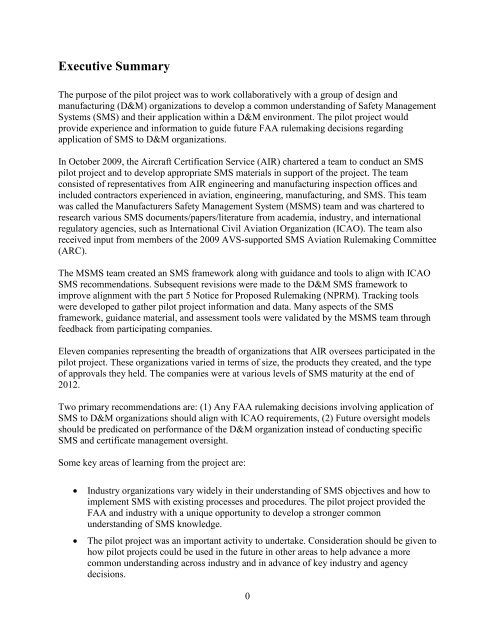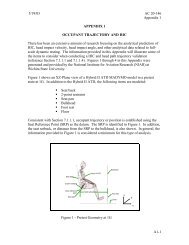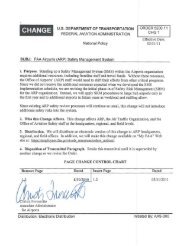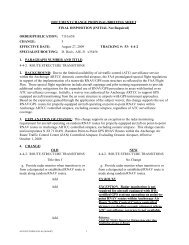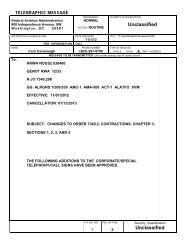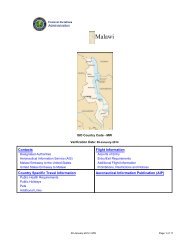2009 SMS Pilot Project (SMSPP) Analysis - FAA
2009 SMS Pilot Project (SMSPP) Analysis - FAA
2009 SMS Pilot Project (SMSPP) Analysis - FAA
Create successful ePaper yourself
Turn your PDF publications into a flip-book with our unique Google optimized e-Paper software.
Executive Summary<br />
The purpose of the pilot project was to work collaboratively with a group of design and<br />
manufacturing (D&M) organizations to develop a common understanding of Safety Management<br />
Systems (<strong>SMS</strong>) and their application within a D&M environment. The pilot project would<br />
provide experience and information to guide future <strong>FAA</strong> rulemaking decisions regarding<br />
application of <strong>SMS</strong> to D&M organizations.<br />
In October <strong>2009</strong>, the Aircraft Certification Service (AIR) chartered a team to conduct an <strong>SMS</strong><br />
pilot project and to develop appropriate <strong>SMS</strong> materials in support of the project. The team<br />
consisted of representatives from AIR engineering and manufacturing inspection offices and<br />
included contractors experienced in aviation, engineering, manufacturing, and <strong>SMS</strong>. This team<br />
was called the Manufacturers Safety Management System (M<strong>SMS</strong>) team and was chartered to<br />
research various <strong>SMS</strong> documents/papers/literature from academia, industry, and international<br />
regulatory agencies, such as International Civil Aviation Organization (ICAO). The team also<br />
received input from members of the <strong>2009</strong> AVS-supported <strong>SMS</strong> Aviation Rulemaking Committee<br />
(ARC).<br />
The M<strong>SMS</strong> team created an <strong>SMS</strong> framework along with guidance and tools to align with ICAO<br />
<strong>SMS</strong> recommendations. Subsequent revisions were made to the D&M <strong>SMS</strong> framework to<br />
improve alignment with the part 5 Notice for Proposed Rulemaking (NPRM). Tracking tools<br />
were developed to gather pilot project information and data. Many aspects of the <strong>SMS</strong><br />
framework, guidance material, and assessment tools were validated by the M<strong>SMS</strong> team through<br />
feedback from participating companies.<br />
Eleven companies representing the breadth of organizations that AIR oversees participated in the<br />
pilot project. These organizations varied in terms of size, the products they created, and the type<br />
of approvals they held. The companies were at various levels of <strong>SMS</strong> maturity at the end of<br />
2012.<br />
Two primary recommendations are: (1) Any <strong>FAA</strong> rulemaking decisions involving application of<br />
<strong>SMS</strong> to D&M organizations should align with ICAO requirements, (2) Future oversight models<br />
should be predicated on performance of the D&M organization instead of conducting specific<br />
<strong>SMS</strong> and certificate management oversight.<br />
Some key areas of learning from the project are:<br />
• Industry organizations vary widely in their understanding of <strong>SMS</strong> objectives and how to<br />
implement <strong>SMS</strong> with existing processes and procedures. The pilot project provided the<br />
<strong>FAA</strong> and industry with a unique opportunity to develop a stronger common<br />
understanding of <strong>SMS</strong> knowledge.<br />
• The pilot project was an important activity to undertake. Consideration should be given to<br />
how pilot projects could be used in the future in other areas to help advance a more<br />
common understanding across industry and in advance of key industry and agency<br />
decisions.<br />
0


